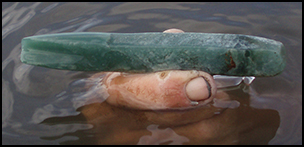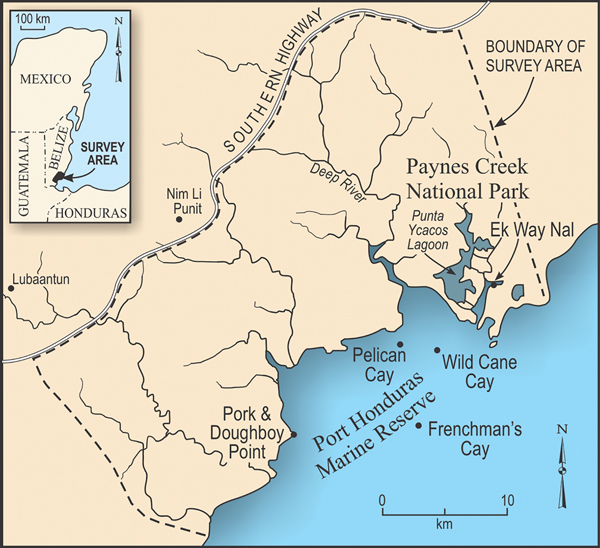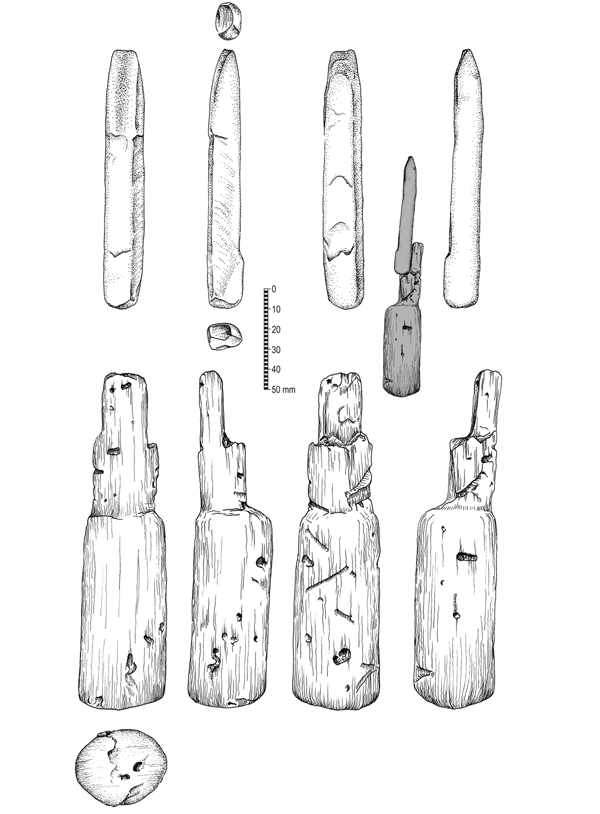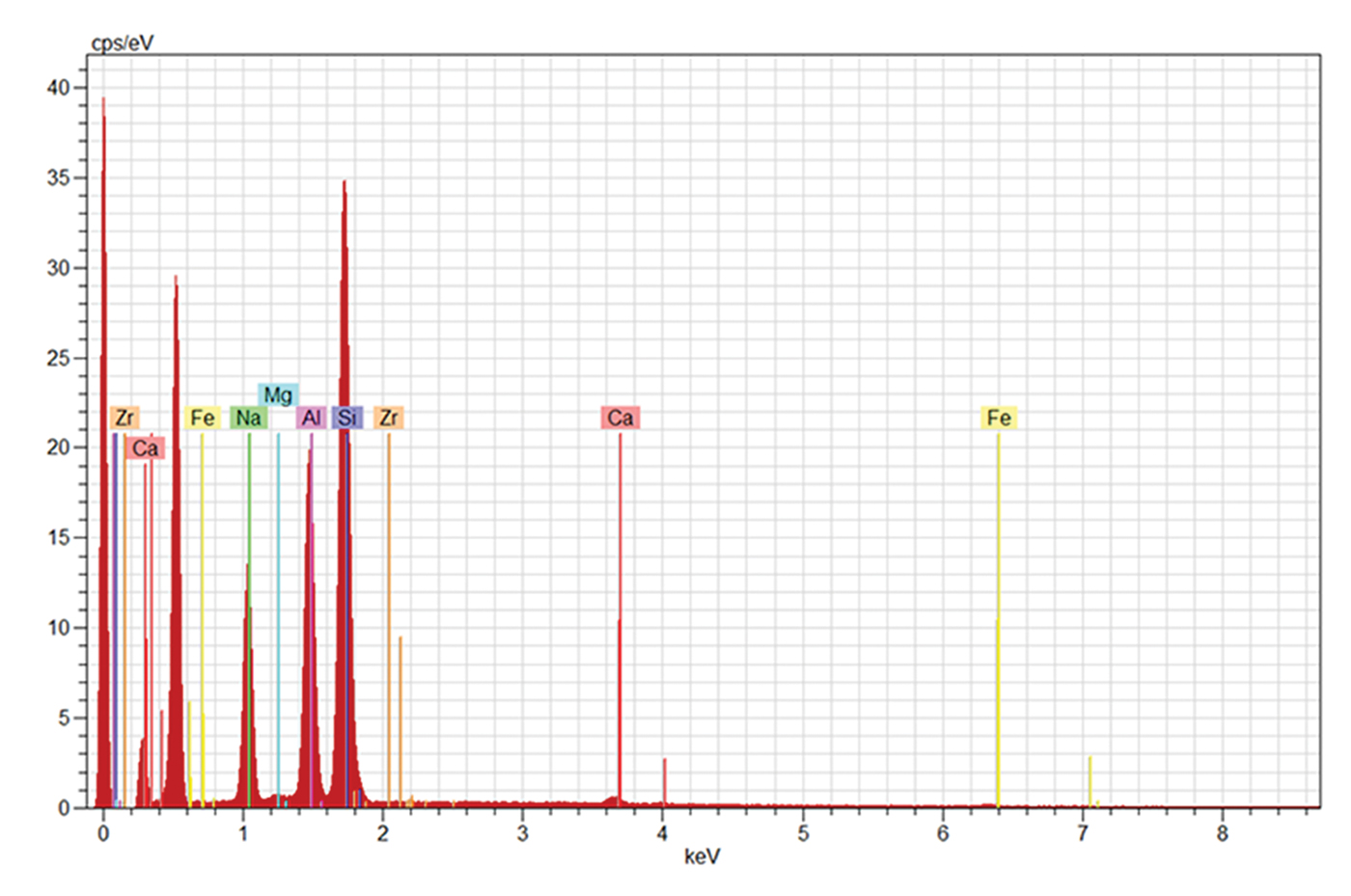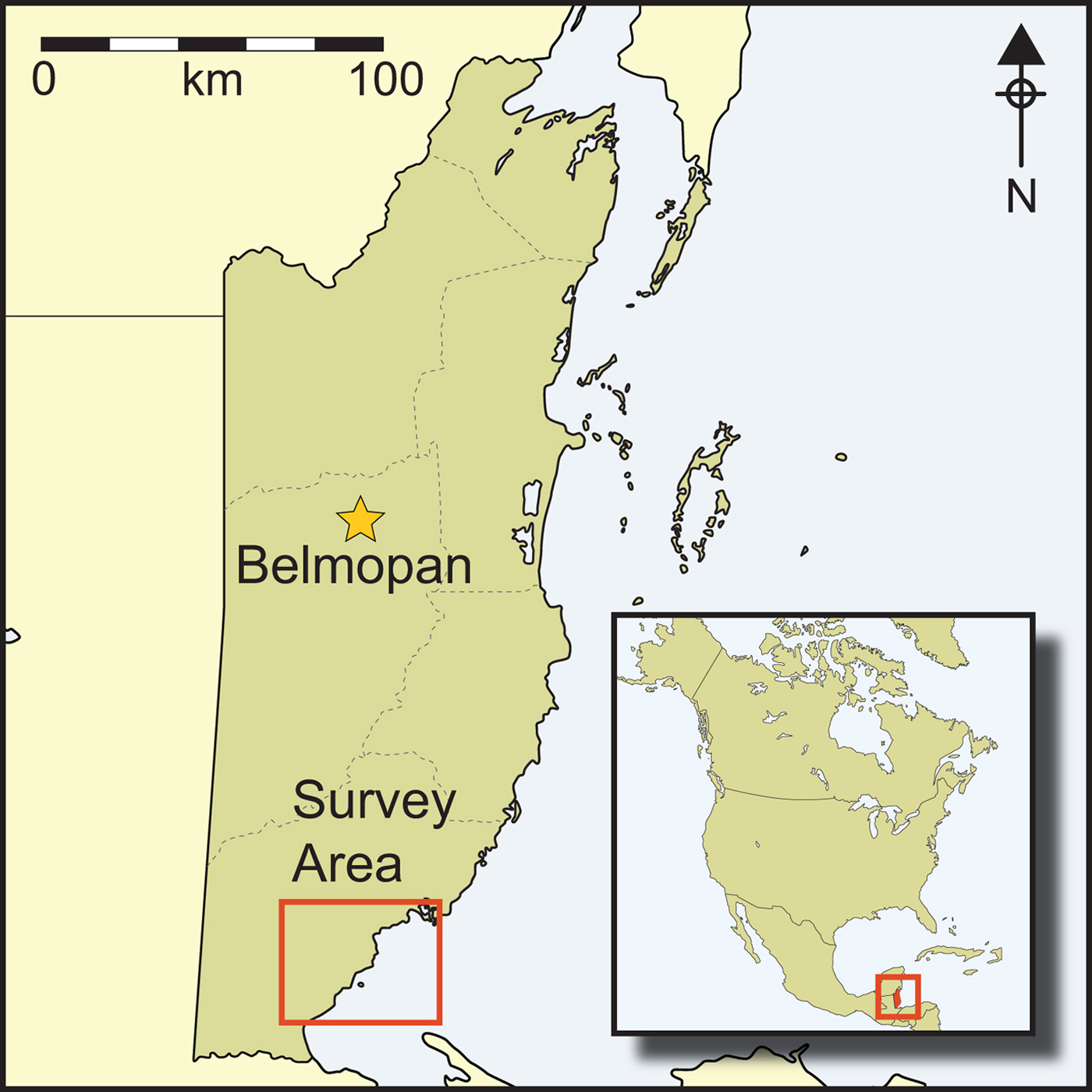
Introduction
The ancient Maya used jadeite objects in burials, caches and other ceremonial contexts from the Middle Preclassic to Postclassic periods (1000 BC–AD 1500; Figure 1; Aoyama et al. Reference Aoyama, Inomata, Pinzon and Palomo2017). During the Classic Period (AD 300–900), the use of high-quality translucent jadeite was typically reserved for unique and elaborate jadeite plaques, figurines and earplugs (earrings) for royalty and other elites (Kovacevich & Callaghan Reference Kovacevich and Callaghan2018). Craft workers closely affiliated with Maya royalty probably finished making these jadeite objects in either palace workshops or household workshops in lowland Maya cities. Debitage from sawing jadeite, for example, was recovered from above King Pacal's tomb at Palenque and in other elite contexts (Melgar et al. Reference Melgar Tisoc, Solis Ciriaco, Filloy Nadal, Velázquez and Lowe2013). Highly crafted jadeite objects were destined for use in dynastic Maya ceremonies, as gifts to other leaders to solidify alliances, or as burial offerings to accompany dynastic and other elites (Halperin et al. Reference Halperin, Hruby and Mongelluzzo2018). The largest jadeite artefact (4.4kg) is a depiction of the sun god from a royal tomb at Altun Ha, Belize (Pendergast Reference Pendergast1982: fig. 33). An incised jadeite plaque from a royal burial at Nim li Punit, in Belize, resembles chest ornaments worn by dynastic leaders, who are depicted and described in hieroglyphs on stelae engaging in ritual scattering of copal incense (Prager & Braswell Reference Prager and Braswell2016: figs 1 & 8–9). Jadeite had a ceremonial function as early as the Middle Preclassic (1000–300 BC), as evidenced at Ceibal, Guatemala, where dozens of jadeite and other greenstone celts (axes) were placed in caches under public plazas (Aoyama et al. Reference Aoyama, Inomata, Pinzon and Palomo2017).
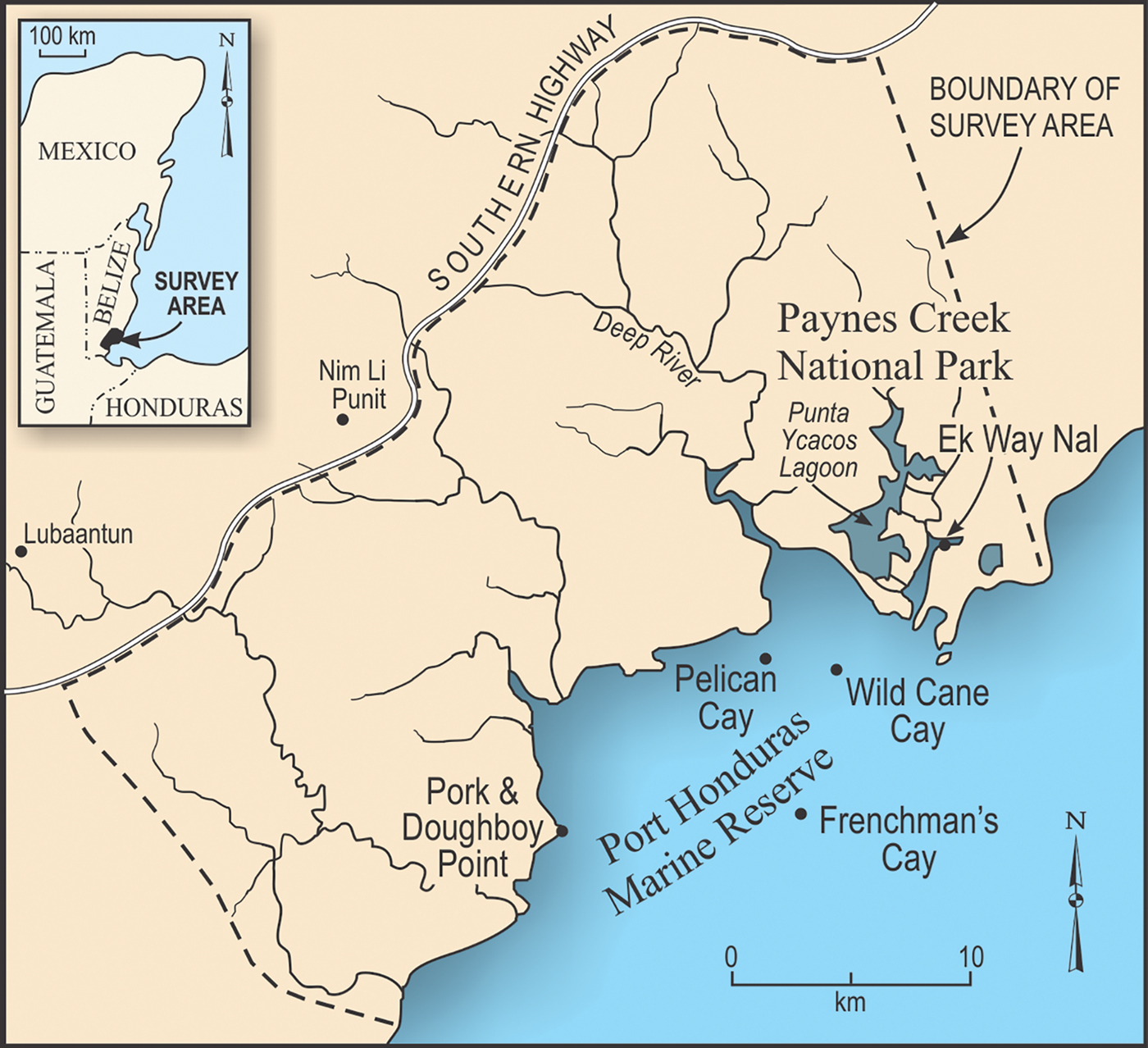
Figure 1. Map of the southern Belize survey area showing the location of Ek Way Nal in the Punta Ycacos lagoon. Inset shows location of Ek Way Nal in the Maya area (figure by Mary Lee Eggart).
In contrast, beads and celts made from jadeite and other greenstones of varying quality were widely distributed at Tikal, Cancuen and other lowland cities, being found in archaeological contexts associated with both elites and commoners (Masson & Freidel Reference Masson and Freidel2012; Kovacevich & Callaghan Reference Kovacevich and Callaghan2018). Even at small Maya communities, such as Ceren, nearly every household had a greenstone celt (Sheets Reference Sheets2000). This pattern of access indicates that jadeite was available at local marketplaces, along with other trade and craft goods and resources from surplus household production. Jadeite beads, and possibly celts, may have been used as a medium of exchange (Freidel et al. Reference Freidel, Masson and Rich2017). Aoyama et al. (Reference Aoyama, Inomata, Pinzon and Palomo2017) demonstrated that in Middle Preclassic caches at Ceibal, a total of 23 per cent of celts made from greenstone or other rocks—including two from jadeite—had been used for wood-working prior to their deposition, whereas the other celts, including those of blue-green translucent jadeite, were unused. This suggests that, except for the finest green-blue translucent jadeite, some celts were similarly used by the Classic Maya for utilitarian purposes.
Ancient Maya stone tools are seldom recovered with their original wooden handles, as organic preservation is dependent on specific environmental conditions (Shafer & Hester Reference Shafer, Hester and Pohl1990: fig 9.1; Coggins & Ladd Reference Coggins, Ladd and Coggins1992: 260–63, fig 8.37). This article presents the first report of a Maya jadeite tool—a gouge—found with its associated wooden handle. The tool was recovered from Ek Way Nal, an underwater site in southern Belize—one of 110 sites comprising the Paynes Creek Salt Works (Figure 1). The discovery of a jadeite tool in a utilitarian context is noteworthy, as high-quality translucent jadeite is normally associated with ritual or ceremonial contexts in the Maya area. The Ek Way Nal jadeite tool comes from a salt kitchen, a location that contrasts with the more typical Maya burial and cache contexts for translucent blue-green jadeite artefacts.
The Ek Way Nal tool is made of exceptionally high-quality jadeite, which is surprising given its utilitarian context. Jadeite is a hard rock that varies from translucent to opaque. The translucent appearance of the Ek Way Nal tool results from tightly woven grains in the material, which make the jadeite particularly durable and, therefore, even more desirable for use as a tool. At Ek Way Nal, salt workers probably obtained the jadeite gouge as part of a surplus household economy that related to the production and distribution of salt (McKillop Reference McKillop2019; McKillop & Aoyama Reference McKillop and Aoyama2018). The gouge, along with celts made from jadeite and other minerals found elsewhere at the site, formed part of this economy. This article describes the archaeological context of the jadeite gouge and its wooden handle, as well as geological and use-wear analysis wood-species identification and the method used to conserve the handle.
The Paynes Creek Salt Works
The Paynes Creek Salt Works comprised dozens of wooden salt kitchens built by the Classic Maya (AD 300–900) along the shoreline of seasonally hyper-saline Punta Ycacos Lagoon (Figure 1). Brine was boiled in ceramic containers over fires to make salt, leaving behind briquetage as evidence (McKillop Reference McKillop2005a; McKillop & Sills Reference McKillop, Sills, Matthews and Guderjan2017). The thatched, wooden salt kitchens allowed for year-round production, as well as the storage of wood fuel, pots and salt. This interpretation is based on modern salt-making at Sacapulas in highland Guatemala, where salt production inside dedicated buildings occurs mainly during the dry season, but also continues during the rainy season (Reina & Monaghan Reference Reina and Monaghan1981). In southern Belize, there is considerable rainfall year-round, making indoor salt production desirable (McKillop Reference McKillop2019: fig. 4.1).
Following their abandonment sometime after the end of the Classic Period, rapid sea-level rise flooded the salt works, leaving them underwater and invisible in the modern mangrove landscape (McKillop et al. Reference McKillop, Sills and Harrison2010). Red mangroves (Rhizophora mangle L.) respond to more gradual sea-level rise by growing taller to keep their leaves above water; in turn, this propagates the formation of mangrove peat. The depth of the peat can be used as a proxy for measuring sea-level rise (Toscano & Macintyre Reference Toscano and Macintyre2003). There is over 5m of mangrove peat below the sea floor in the lagoon, indicating that prior to the Maya Classic Period, seas rose and then stabilised, creating land (McKillop et al. Reference McKillop, Sills and Harrison2010). The peat also creates an anaerobic matrix that preserves wood and other organic remains. Mapping at 70 underwater sites has recorded over 4000 wooden posts defining rectangular buildings, as well as other wooden objects preserved in peat below the sea floor (McKillop Reference McKillop2005a, Reference McKillop2019; McKillop & Sills Reference McKillop, Sills, Matthews and Guderjan2017). The sites are concentrated in a 5km2 area in Punta Ycacos Lagoon, with evidence of contemporaneous settlement elsewhere in the coastal area from the Middle Preclassic through the Postclassic (Figure 1; McKillop Reference McKillop2005b; McKillop & Robertson Reference McKillop and Robertson2018).
Jadeite quarrying, exchange and craftworking
Jadeite outcrops and quarries have been identified along both sides of the Motagua River in Guatemala (Figure 2; Hammond et al. Reference Hammond, Aspinall, Feather, Hazelton, Gazard, Argell, Earle and Ericson1977; Harlow Reference Harlow and Lange1993, Reference Harlow1994; Seitz et al. Reference Seitz, Harlow, Sisson and Taube2001; Harlow et al. Reference Harlow, Hemming, Lallemant, Sisson and Sorensen2004, Reference Harlow, Murphy, Hozjan, De Mille and Levinson2006; Taube et al. Reference Taube, Sisson, Seitz, Harlow and Taube2004). Jadeite is one of several minerals present in the outcrops. Abrasive blocks used for shaping stone have been found at quarry sites in the middle Motagua Valley (Rochette Reference Rochette and Hirth2009). Elite and commoner householders in nearby communities were involved in shaping raw jadeite using percussion methods, as well as in making jadeite beads, celts and plaques by sawing and drilling (Rochette Reference Rochette and Hirth2009). Blanks or preforms, as well as finished jadeite objects from the outcrops and associated sites were widely traded to lowland Maya cities in Guatemala, Belize, Honduras and Mexico, where value was added by elite specialists who further crafted the jadeite into elaborate objects. These were gifted among dynastic and other nobles and deposited in caches and burials. Lowland Maya commoners, however, also had access to jadeite and other valuable commodities through marketplace trade, although not in the same abundance or quality as found in dynastic burials and caches.
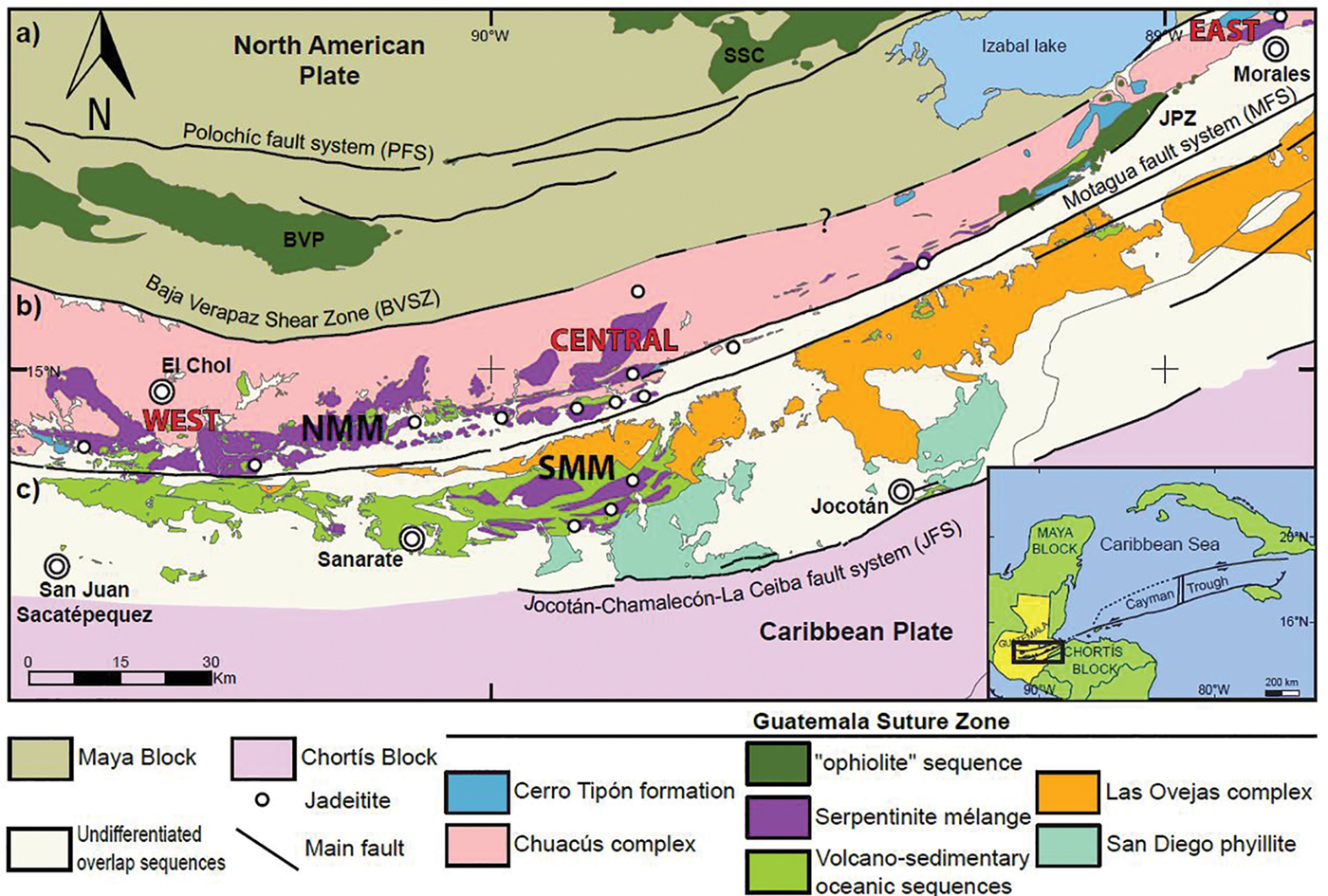
Figure 2. Map of the middle Motagua jadeite zone in Guatemala, with inset showing its location in Central America (figure by George Harlow).
Some Maya jadeite objects were produced in commoner household workshops in the Maya Lowlands. Jadeite objects were considered valuable commodities that could be stored and traded or gifted, for example, in times of crop failure (Rochette Reference Rochette and Hirth2009). Workshops at Cancuen, a riverine port in the Guatemalan interior, produced jadeite beads and earplugs (Andrieu et al. Reference Andrieu, Rodas and Luin2014); elites and commoners carried out production at the Motagua River valley outcrops and at some workshops, including at Cancuen, although the Cancuen elite may have controlled the acquisition of the raw material and its distribution to other communities. Canoe trade down the Motagua River and along the Caribbean coast of Belize provided direct access to jadeite for coastal communities—including the salt workers at Ek Way Nal. Jadeite beads, for example, were interred in graves at the nearby trading port on Wild Cane Cay (McKillop Reference McKillop2005b: fig. 6.23; Figure 1).
Underwater survey and mapping at Ek Way Nal
The underwater site of Ek Way Nal is located in the main channel of Punta Ycacos Lagoon, a large salt-water system ranging in depth from a few centimetres to over 2m. Systematic survey was carried out by a team of archaeologists who traversed sections of the lagoon side by side on research flotation devices (RFDs), marking the location of wooden posts and artefacts on the sea floor (Figure 3). In shallow water, survey flags were placed to mark post and artefact locations. Each location was then mapped individually using a total station and entered into the project GIS (Figure 4). Wood samples for radiocarbon dating and tree-species identification were cut from the top of 204 posts using a stainless steel kitchen knife (seven were too hard to sample); 109 were identified in the field as being made from palmetto palms (Acoelorrhaphe wrightii). In order to obtain wood free from burrowing sea worms, the mangrove peat was cleared from around a post; samples of preserved wood from the posts below the sea floor were then taken. These wood samples were placed in bags of fresh water, desalinated by periodic water changes and stored for analyses.
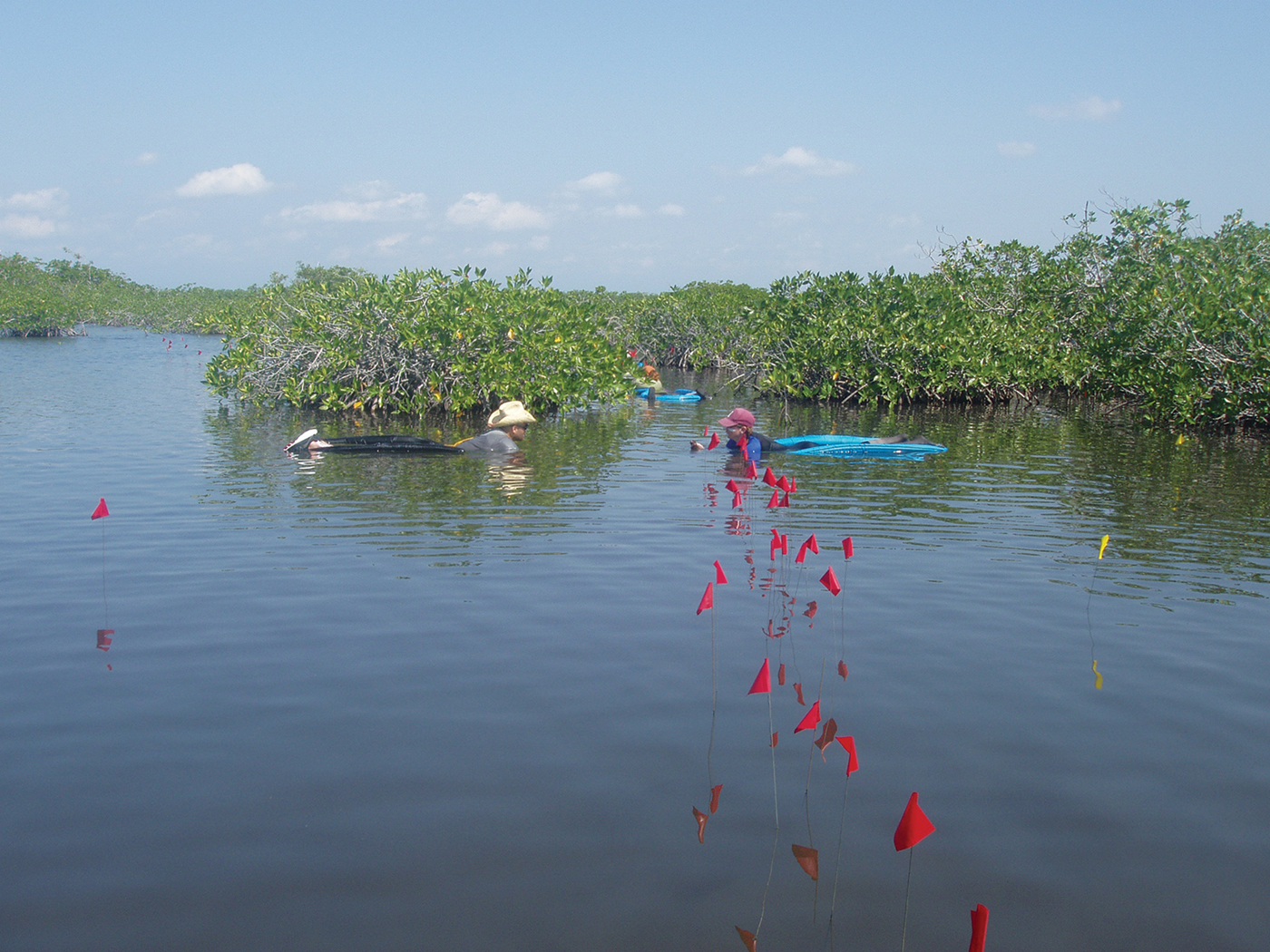
Figure 3. Survey at Ek Way Nay on RFDs (research flotation devices), with flags marking the locations of sea-floor wooden posts (photograph by Heather McKillop).
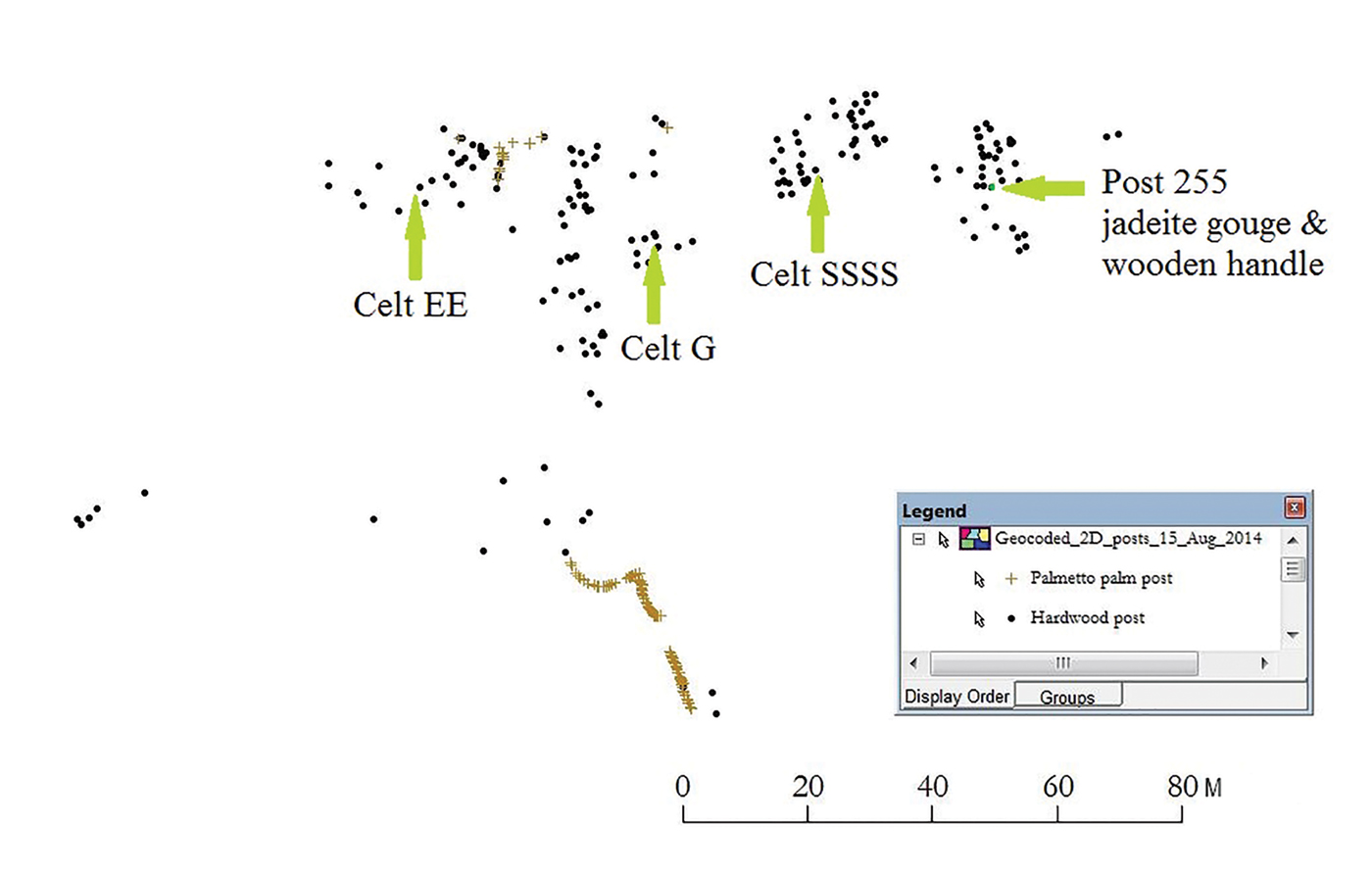
Figure 4. Distribution of wooden posts at the Ek Way Nal site; arrows indicate the locations of jadeite celts and the jadeite gouge and handle found beside post 255 (figure by Heather McKillop).
Clearance of peat from around post 255 revealed a jadeite gouge and its associated wooden handle (Figures 4–7). The objects were discovered leaning against a post inside a wooden salt kitchen. The tool may have originally been placed against the post, or it could have fallen from rafters above or from a shelf, or from a hook on the post. Post 255 is of a local hardwood, prickly yellow (Zanthoxylum sp.), which is commonly used for modern building construction in southern Belize. Despite the high quality of the jadeite from which the gouge was made, the find's context is distinctly utilitarian.
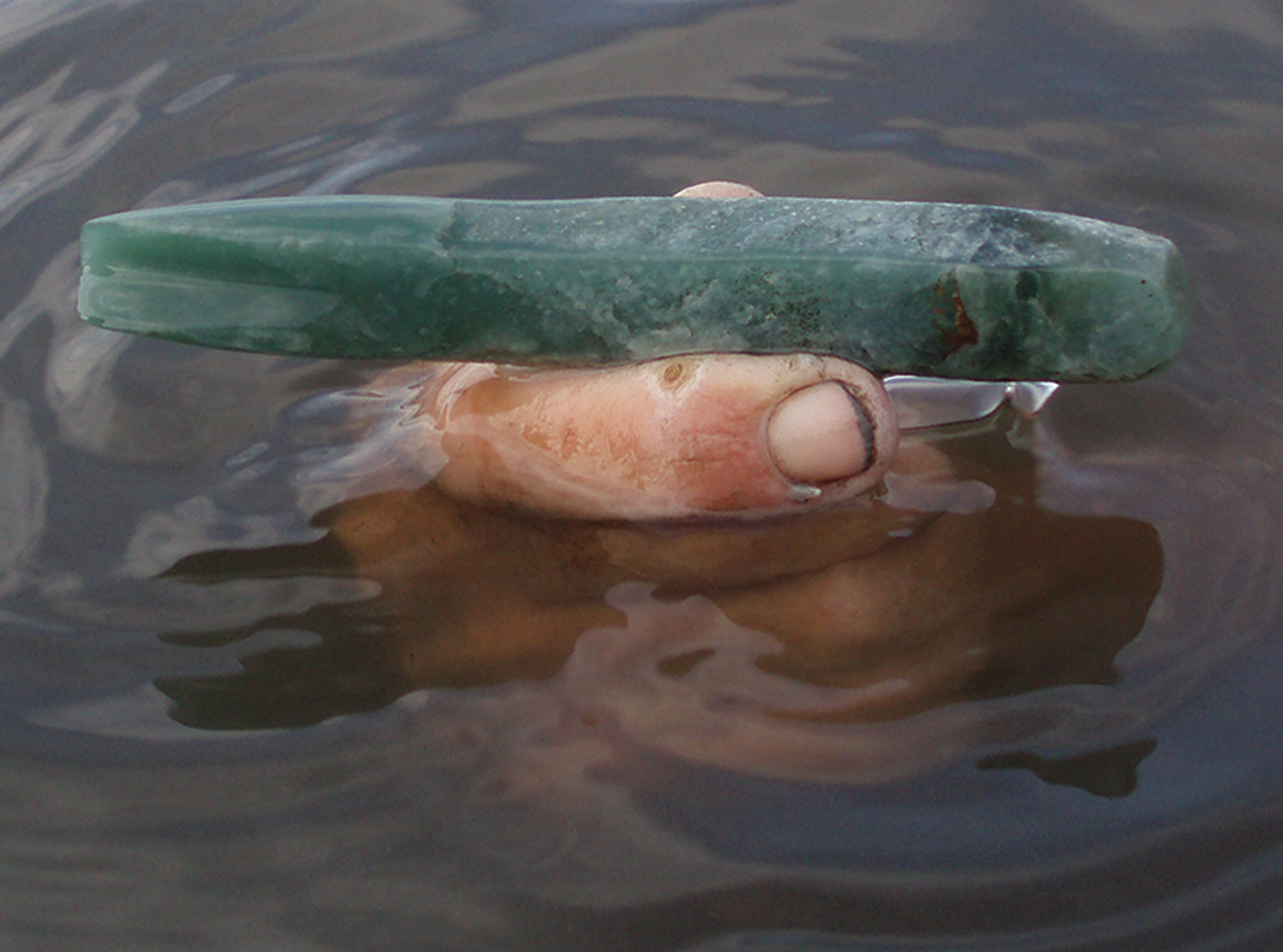
Figure 5. The jadeite gouge after discovery (photograph by Heather McKillop).

Figure 6. Wooden handle for the jadeite gouge (photograph by Heather McKillop).
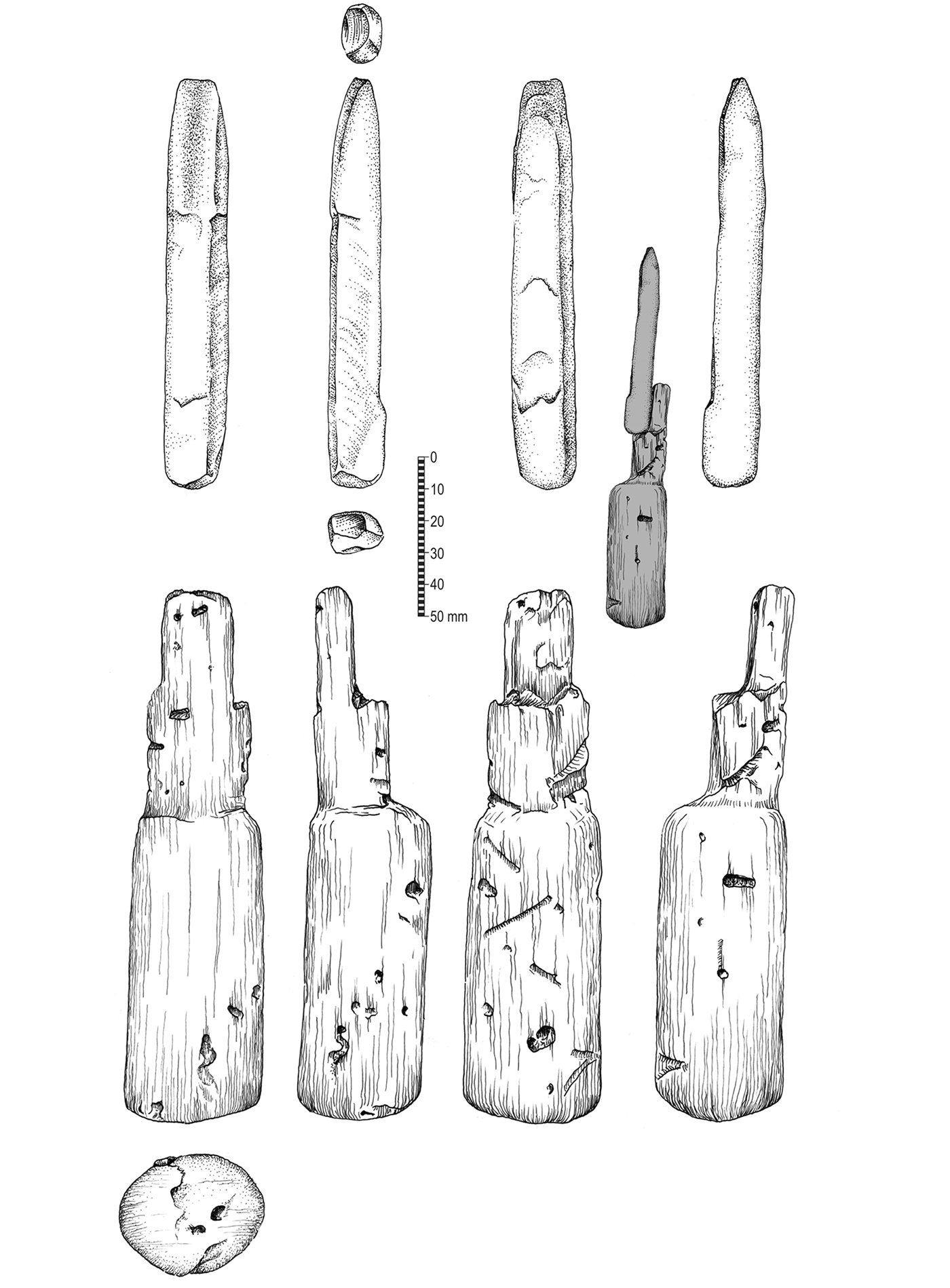
Figure 7. Drawings of the gouge and handle (figure by Mary Lee Eggart).
Radiocarbon dates on post 255 and on the wooden handle place both in the Late (AD 600–800) to Terminal (AD 800–900) Classic Periods. An AMS measurement on the handle gives a date of cal AD 660–810 (2σ), while a standard radiocarbon date on post 255 provides an age of cal AD 680–970 (2σ) (Table 1). A Late Classic date range for the site is further supported by Late to Terminal Classic pottery, including small quantities of chronologically distinctive pottery, such as Belize Red dishes and Warrie Red jars with characteristic stamped decorations (McKillop Reference McKillop2019).
Table 1. Radiocarbon dates from Ek Way Nal post 255 and from the associated wooden handle.

Mineral identification
The jadeite gouge was analysed at the American Museum of Natural History to determine the object's chemical composition and mineral phases. The object was examined with an electron microprobe (Cameca SX100) including backscattered-electron (BSE) images, SEM (Zeiss EVO 60 with Bruker energy-dispersive X-ray spectroscopy) and X-ray microdiffraction (Rigaku DMAX/Rapid). These analyses reveal that the tool is of exceptionally high quality and is compositionally consistent with jadeite samples from the Motagua River valley in Guatemala (Figure 8). To view the mineral microtexture and to provide a suitable sample for microprobe analysis, a small piece was removed from the non-display side of the butt end and polished. The gouge was determined to be of high quality, with around 98 vol% jadeite, which is marginally zoned between nearly pure jadeite and approximately 10% mol% (molar percentage of other pyroxene compositions) diopside+hedenbergite+aegirine. Other mineral phases include analcime (along some grain boundaries, or as small inclusions), omphacite (a pyroxene phase that is about half diopside and half jadeite), barian K-feldspar, zircon and titanite. This is consistent with a Guatemalan source, and resembles some of the very fine Olmec-like jade artefacts. As an example of jadeite jade, the gouge approaches the quality of so-called ‘gem grade’ material, in that it has a translucent blue-green colour often associated with objects from Formative (Olmec) sites. Translucency is conferred by a tight microstructure of intersecting jadeite grains; this structure also confers mechanical durability.

Figure 8. Energy-dispersive X-ray spectrum showing elemental abundances at dark zone in gouge that is nearly pure jadeite. Zr = zirconium; Ca = calcium; Fe = iron; Na = sodium; Mg = magnesium; Al = aluminium; Si = silicon. Bruker HV: 15.0 kV Puls th.: 6.87 kcps (figure by George Harlow).
Petrologically, the artefact is a jadeitite with little other than pyroxene with subtle and complex zoning of tightly intergrown jadeite grains and rare small zircon and titanite grains. It is interspersed with veins of more evolved (diopside-richer) jadeitite and late complex veins of varying jadeite and omphacite compositions, with occasional barian K-feldspar grains. Jadeite grains are rhythmically zoned from Jd100 to about Jd90—the near-0 to 10 mol% composed primarily of diopside with hedenbergite and aegirine in descending abundance. The high-quality jadeite used to make the Ek Way Nal gouge is rare, but does occur in the Guatemalan source area. Moreover, as mica, lawsonite and quartz were not detected in the composition of the jadeite, it is impossible to determine from which side of the Motagua Fault the jadeitite was sourced.
Wooden handle
Thin slices of the wooden handle were taken using a backed razor. Analysis of the wood's structure shows that the handle is made from Honduras rosewood (Dalbergia stevensonii Standl.), as indicated by the presence of characteristic storied rays. Honduras rosewood is locally available in the deciduous forest on the south side of the Deep River, and more generally in southern Belize (Figure 1; Wright et al. Reference Wright, Romney, Arbuckle and Vial1959).
The rosewood handle was conserved using the polymer method (Smith Reference Smith2003) at Texas A&M University. To provide a digital record, the wooden handle and jadeite gouge were imaged separately using a NextEngine 3D desktop scanner in the Digital Imaging and Visualization in Archaeology (DIVA) laboratory at Louisiana State University. As with previous waterlogged finds from the Paynes Creek Salt Works, printed replicas were made from the 3D scans for use in exhibitions and for public outreach (McKillop & Sills Reference McKillop and Sills2013; McKillop Reference McKillop2016).
Use-wear analysis of the jadeite gouge
Questions regarding the jadeite artefact include the extent to which its use may have left traces along the working edge, the character of that wear and the presence of hafting traces. All of these lines of evidence may contribute towards understanding how the tool was used. The artefact resembles a gouging tool that would be used to make wide grooves, based on morphology. As with any stone tool created by grinding and abrasive polishing, it is difficult to distinguish between manufacturing- and use-related wear. The distal end of the tool has been ground and polished to a smooth surface. Both the right lateral edges of faces A and C are reflective and smooth (Figure 9). The opposite two edges (left lateral edges) are smooth only near the tip, and display considerable crushing and pecking, especially near the proximal end. A unidirectional grinding/abrasive action has produced the concave distal end of the tool (Figure 9). Clear directionality in wear parallel to the long axis of the piece is macroscopically visible. Grinding and abrading to shape the tool has resulted in highly polished surfaces on all faces at the distal end. More shaping characterises the distal end of the tool on faces A and B, with less shaping and grinding on faces C and D. The sides have a matte polish that reflects less use than the deeper, central part of the groove. As the groove deepened, it may have been easier for the manufacturer to control the motion of the abrasives used in its creation. Therefore, the bottom of the groove has a more homogeneous surface than its sides.
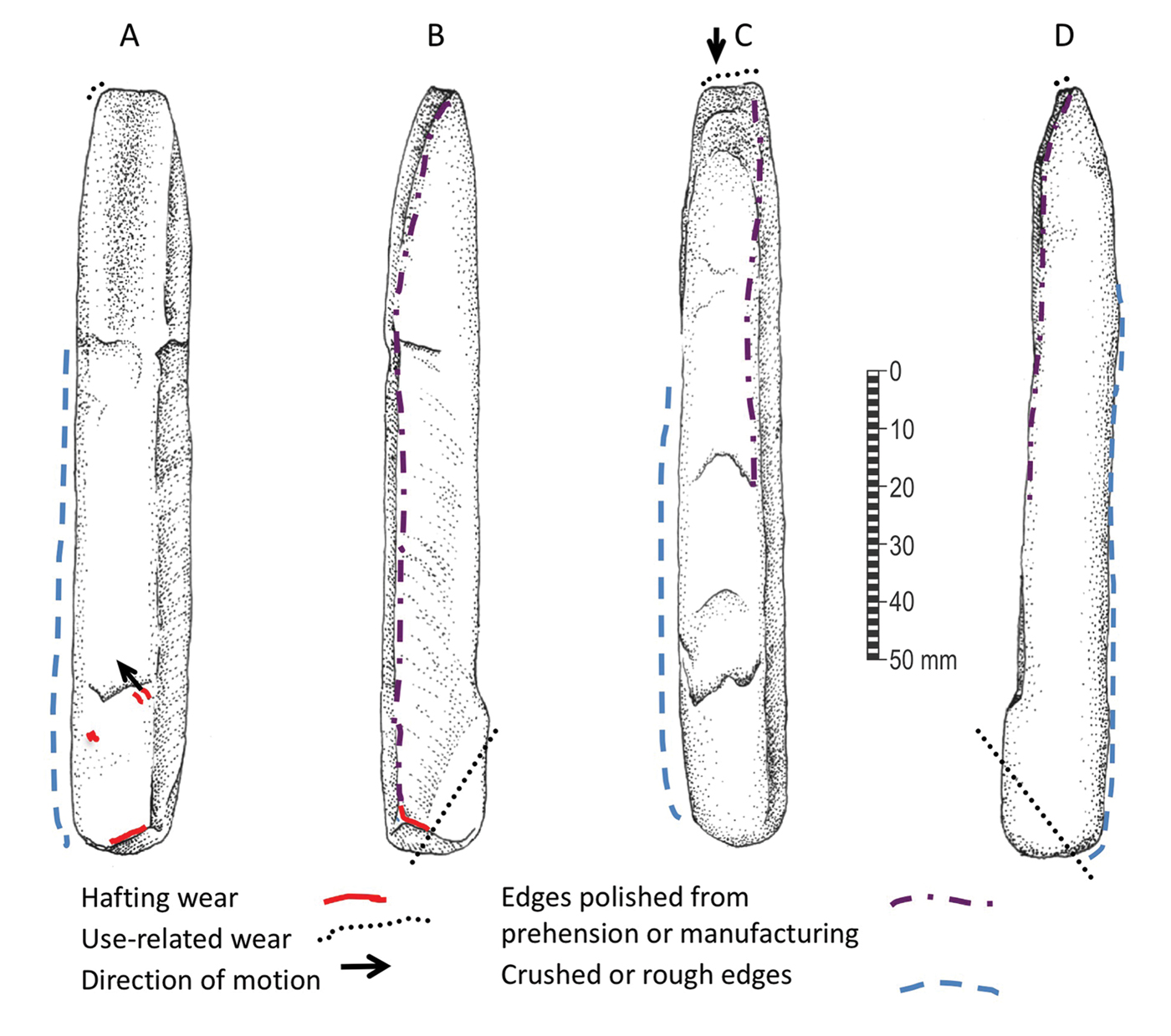
Figure 9. Drawing of jadeite gouge showing locations of wear from hafting to the wooden handle and from use (figure by April Sievert).
Haft traces show abrasive wear from rubbing, as typically seen on chipped stone implements hafted in wood. Wear is present on the proximal end of the tool, particularly on face A. Although the handle was hafted close to the jadeite tool, it was sufficiently loose—perhaps imperceptibly so, for the user—for haft wear traces to form (Figure 7). Visible but less well-developed hafting wear is present along the ridges on the base (proximal face) of the implement. This suggests that the implement was less tightly hafted here, resulting in less hafting wear during use. Wear traces identified along the right lateral edge of face A may be the result of polishing during manufacture, or due to contact with a hand during use.
The distal edge on face C was the area of contact when the jadeite implement was in use (Figure 9). Stereomicroscopic analysis shows a matte surface polish on this distal edge that probably resulted from use and edge rounding. The rounding extends along almost the entire distal edge. The polish is clearly directional, showing motion perpendicular to the edge. Neither micro flaking nor damage in the form of crushing is present along the working edge, although jadeite may be resistant to these actions. The absence of crushing implies that the worked material was not extremely hard; if the gouge had been used to work very hard material, such as stone, bone or antler, at least some crushing might be expected.
The edge rounding on the distal end is associated with a light matte polish and a slight bevel, just posterior to the working bit. If the tool was used in woodworking, a bright, spreading polish—similar to the hafting traces—would be expected. Instead, the wear is neither as bright nor as well developed as that generated from contact with the haft. The gouge, although bearing evidence of mechanical use in the form of hafting traces on the proximal end, and a wear trace along the dorsal side of the working edge, was therefore not used to carve wood. The polish and edge modification at the tip indicate directionality perpendicular to the working edge. No distinctive polish or use-related contact is visible on face A, other than a spot of polish at the intersection of the left lateral edge and the bit. This feature runs parallel to the long axis, with visible directionality. This spot of polish might indicate contact with wood, but could also result from manufacturing. The jadeite gouge does not appear to have been used on a particularly hard material, nor does it appear to have been used primarily for woodworking. Other uses are possible but yet to be determined.
Discussion
Recovery of the jadeite gouge and handle at the Ek Way Nal salt works emphasises the probability that jadeite and other stone tools were fitted with wooden handles, which have not survived at most Maya sites. The use of jadeite as a utilitarian tool in a salt works indicates that even exotic materials, which often require expertise to fashion into tools, were selected for their hardness. Although the gouge was probably not employed in working wood or hard materials, it may have been used in other activities at the salt works, such as scraping salt, cutting and scraping fish or meat, or cleaning calabash gourds (see McKillop & Aoyama Reference McKillop and Aoyama2018). The jadeite tool may have been obtained by the salt workers travelling to regional marketplaces with their salt cakes and salted fish (McKillop Reference McKillop2019). Alternatively, the salt workers or other mariners may have travelled to the Motagua River, which is only 70km by water, and then upriver to the jadeite outcrops.
Artistic depictions, boat models from the salt works and elsewhere (McKillop Reference McKillop2002: fig 3.38 b–d, Reference McKillop and Balard2017: fig 4) and settlement on offshore islands also indicate the use of boat and canoe navigation dating to the Classic Period (McKillop Reference McKillop and Balard2017). The wooden canoe paddle from the K'ak'Naab’ site and a canoe from the Eleanor Betty site—two other Late Classic sites at the Paynes Creek Salt Works—provide primary evidence of boat travel in the Maya area and specifically at the Paynes Creek Salt Works (McKillop Reference McKillop2005a: fig. 2, Reference McKillop2010, Reference McKillop and Balard2017; McKillop et al. Reference McKillop, Sills and Cellucci2014: fig. 12).
A variety of non-local goods from Ek Way Nal and other sites that comprise the Paynes Creek Salt Works include figurine whistles and unit-stamped pottery from nearby inland sites, such as Lubaantun (Hammond Reference Hammond1975; McKillop Reference McKillop2002). Belize Red pottery came from farther away in the Belize River Valley; chert was probably sourced from the high-quality outcrops in northern Belize and obsidian came from the Maya highland sources of Ixtepeque and El Chayal (McKillop Reference McKillop2019). The salt workers produced salt that they traded at regional markets in southern Belize, acquiring other commodities in return. Some goods may have been obtained during boat trips to the Motagua outcrops or from coastal traders who stopped at the nearby trading port of Wild Cane Cay (McKillop Reference McKillop2005b). The salt workers, for example, obtained celts made from jadeite and other rocks that were at outcrops along the Motagua River. Figure 10 shows three such jadeite celts found at Ek Way Nal.
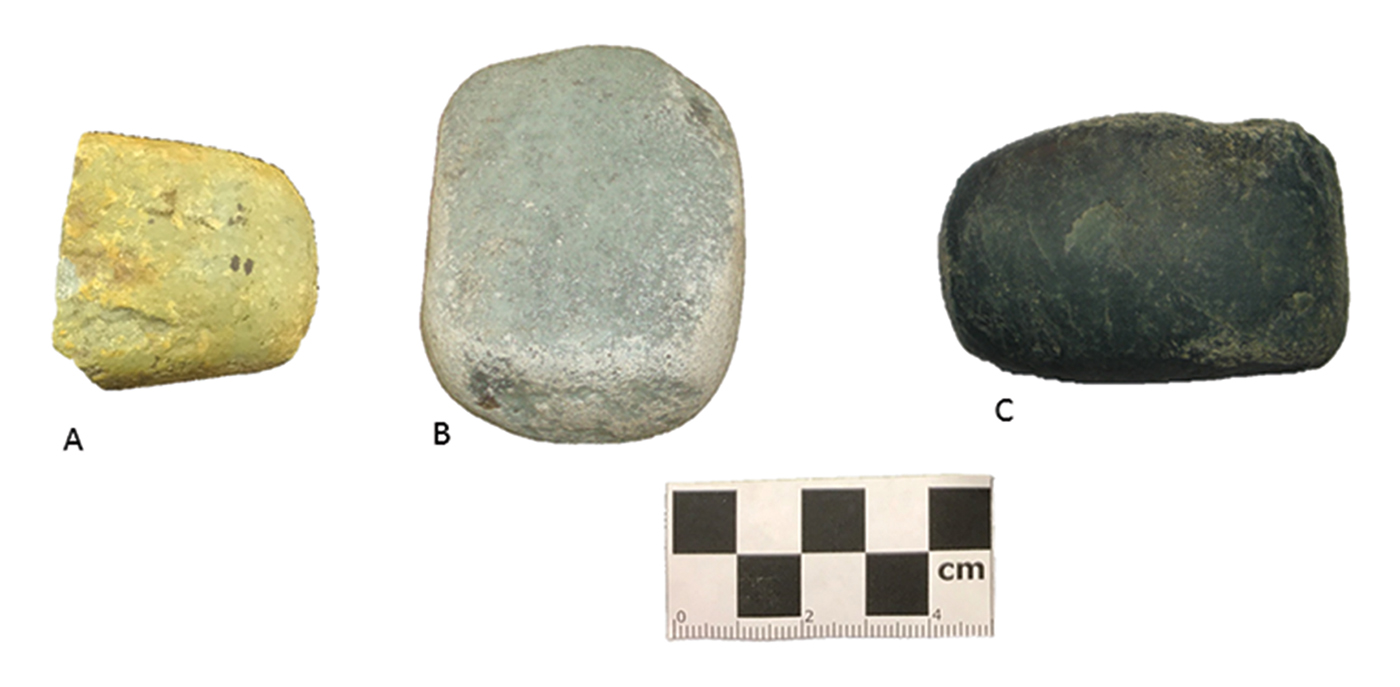
Figure 10. Jadeite celts (75 per cent jadeite and 25 per cent omphacite) from Ek Way Nal: A) 60 EE (fragment); B) 60 SSSS; C) 60 G. For celt locations at the site, see Figure 4 (figure by Cheryl Foster).
Salt was important to the Maya and other ancient civilisations as a dietary supplement and for the preservation of fish. Salt cakes were a commodity traded at Maya marketplaces, as still practised today by modern salt makers in the Maya highlands and elsewhere (Reina & Monaghan Reference Reina and Monaghan1981). Standard-sized salt cakes were traded both locally and regionally as currency equivalencies; they could be stored—along with salted fish—for later use, acting as a risk-management strategy to offset fluctuations in food availability (McKillop & Aoyama Reference McKillop and Aoyama2018; McKillop Reference McKillop2019). Marketplace trade of staple goods and resources made both locally and farther afield is documented at Maya cities, such as Caracol and Tikal, as well as in smaller communities (Sheets Reference Sheets2000; Masson & Freidel Reference Masson and Freidel2012; Chase et al. Reference Chase, Chase, Terry, Horlacher, Chase and King2015).
Conclusions
By the Late Classic Period in the Maya lowlands, multiple spheres of local and long-distance exchange had developed for the acquisition of goods and resources (Sheets Reference Sheets2000; Freidel et al. Reference Freidel, Masson and Rich2017). Elaborate objects made of valuable imported materials circulated among the dynastic Maya rulers of lowland polities, and were used as gifts to create and maintain political alliances. Marketplace trade provided a venue for the exchange of surplus household craft production, as well as ritual and finer goods, including beads and celts made from jadeite and other greenstones. The largest quantities of exotic materials and highly crafted goods were concentrated in city centres amongst the royalty. The plaque from Nim li Punit (Prager & Braswell Reference Prager and Braswell2016)—a site only a short distance from the Paynes Creek Salt Works—provides an example of this. While Nim li Punit would have been one of the marketplace destinations for coastal salt, the plaque was probably acquired through elite gifting.
The depositional context of the Ek Way Nal gouge in a salt kitchen demonstrates that high-quality jadeite was not reserved for, or limited to, elite usage. Mineralogical and use-wear analyses of the gouge show that commoners also had access to the highest-quality jadeite and that the object was used in activities relating to salt making. If not obtained through local marketplace trade, jadeite may have been transported by merchants travelling along the coastal canoe route from the Motagua River valley quarries, or have been directly procured by the salt producers or their delegates.
Without the associated wooden handle and microscopic evidence that the tool had been used before deposition, it may have been viewed as representing a ritual deposit of high-quality jadeite. The translucent appearance of the almost-pure jadeite, which results from the tight microstructure of intersecting jadeite grains, made the material highly durable and desirable as a working implement. Evidently, variability in the quality and translucency of jadeite and other greenstones were important factors in the selection of raw material for making tools.
While jadeite gouges or celts are not typically part of the brine-boiling process at salt works, a greenstone celt was found in a cache at Marco Gonzalez on Ambergris Cay—a community that practised salt making, among other activities (Graham & Pendergast Reference Graham and Pendergast1989: fig. 10). The Ek Way Nal gouge and the other celts do not resemble the anvils or smooth stones used by some potters or salt workers to make pottery vessels for boiling brine (Halliwell et al. Reference Halliwell, Yankowski, Chang, Kelly and Ardren2016). A wooden pottery paddle from the Chak Te'el K'in site, however, indicates the paddle and anvil method was used at the Paynes Creek Salt Works (McKillop Reference McKillop2019: fig 6.5). In this method, a pot was formed by holding a smooth stone or anvil on the inside of a clay pot and hitting the outside of the pot with a wooden paddle to shape it.
The salt workers were successful entrepreneurs who were able to obtain high-quality tools for their craft through the production and distribution of salt. A basic biological necessity that was in demand for the Maya diet, salt was also a storable form of wealth and an important preservative for fish and meat. The choice of high-quality materials, such as jadeite and rosewood, for use in utilitarian tools, demonstrates that the salt workers played an important role in the Classic Maya marketplace economy.
Acknowledgements
Research at Ek Way Nal was carried out by permission of the Belize Government Institute of Archaeology and funded by the National Science Foundation (grant 0513398). Field research was assisted by LSU students Bretton Somers, Cory Sills, Mark Robinson and Amanda Evans, along with Belizean John Young. We are also grateful for the friendship and hospitality of our host family in Belize: Tanya Russ, and John, Lyra and Nathaniel Spang.


